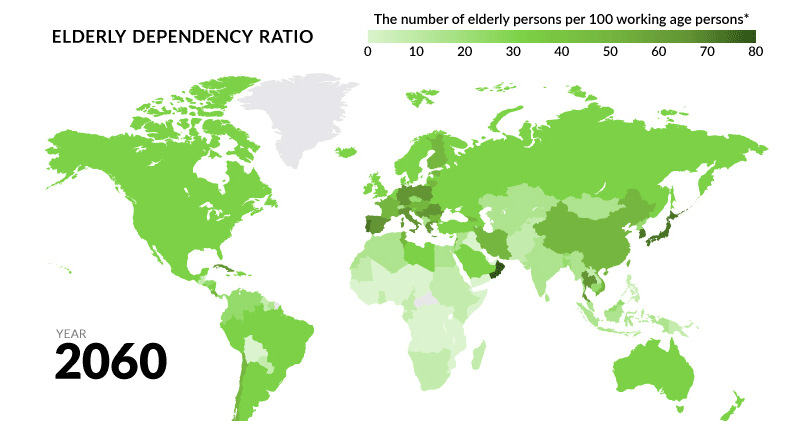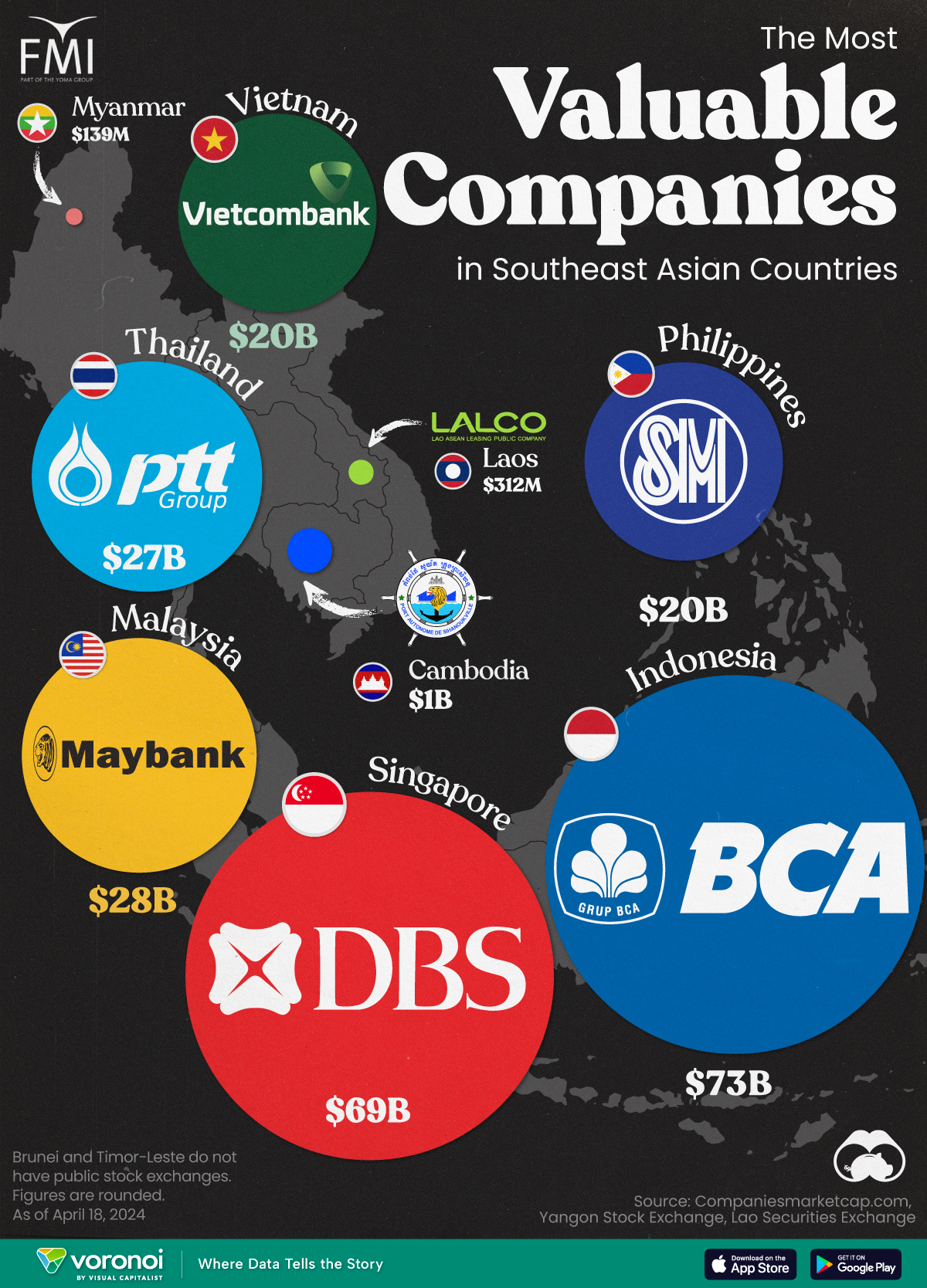Markets
Fertility Rates Keep Dropping, and it’s Going to Hit the Economy Hard
The Chart of the Week is a weekly Visual Capitalist feature on Fridays.
Total fertility rates, which can be defined as the average number of children born to a woman who survives her reproductive years (aged 15-49), have decreased globally by about half since 1960.
This has drastically shaped today’s global economy, but a continued decline could have much more severe long-term consequences. If the world has too many elderly dependents and not enough workers, the burden on economic growth will be difficult to overcome.
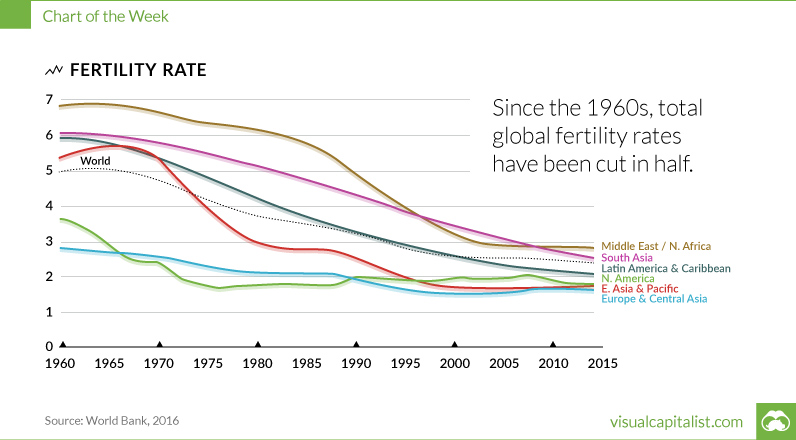
Fertility Rates Start to Decline
First, it’s important to address some of the reasons for these falling fertility rates.
In developed nations the introduction of commercially available birth control has played a large role, but this also coincided with several major societal shifts. Changing religious values, the emancipation of women and their increasing participation in the workforce, and higher costs of childcare and education have all factored into declining fertility rates.
Birthrates Wane, Economy Gains
Initially, reduced child dependency rates were actually beneficial to economic growth.
By delaying childbirth, men and women could gain an education before starting a family. This was important in a shifting labor market where smaller, family-run businesses were in decline and a more skilled and specialized labor force was in demand.
Men and women could also choose to start their careers before having families, while paying more in income taxes and enjoying the benefits of a higher disposable income. Increased spending power creates demand, which stimulates job growth – and the economy benefits in the short-term.
A Global Phenomenon
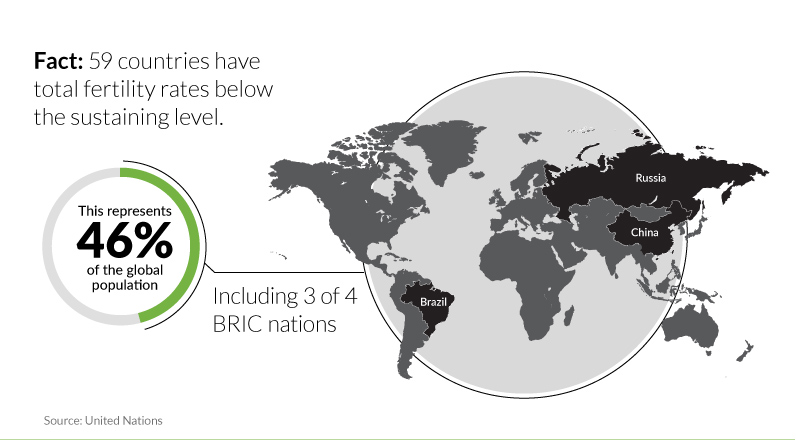
Worldwide fertility rates began to fall substantially in the mid-1960s. While each country has its own underlying causes for this, it is interesting that in developed and developing nations, the downward trend is similar.
Part of this is due to developing countries’ own efforts to rein in their rapidly expanding populations. In China, the One Child Policy was introduced in 1979, however fertility rates had already dropped significantly prior to this. India’s government was also active on this front, sterilizing an estimated 8.3 million people (mostly men) between 1975 and 1977 as a method of population control.
The Age Imbalance
So here we are now, with a global fertility rate of just 2.5 – roughly half of what it was 50 years ago.
Today, 46% of the world’s population lives in countries that are below the average global replacement rate of 2.1 children per woman.
Because these countries (59 to be exact, including BRIC nations Brazil, Russia, and China) are not repopulating quickly enough to sustain their current populations, we are beginning to see a substantial imbalance in the ratio of elderly dependents to working-age people, which will only intensify over the coming decades.
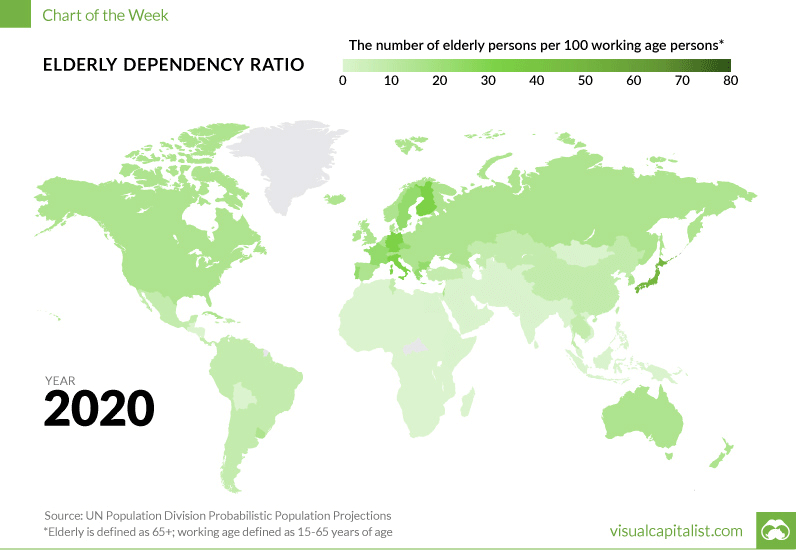
By 2100, the U.N. predicts that nearly 30% of the population will be made of people 60 years and older. Life expectancy also continues to increase steadily, which means those dependents will be living even longer. Between 2000 and 2015 the average global life expectancy at birth increased by around 5 years, reaching an average of 73.8 years for females and 69.1 years for males.
Economic Reversal
What does this mean for the economy?
As this large aging population exits the workforce, most of the positive trends that were spurred by declining fertility rates will be reversed, and economic growth will face a significant burden.
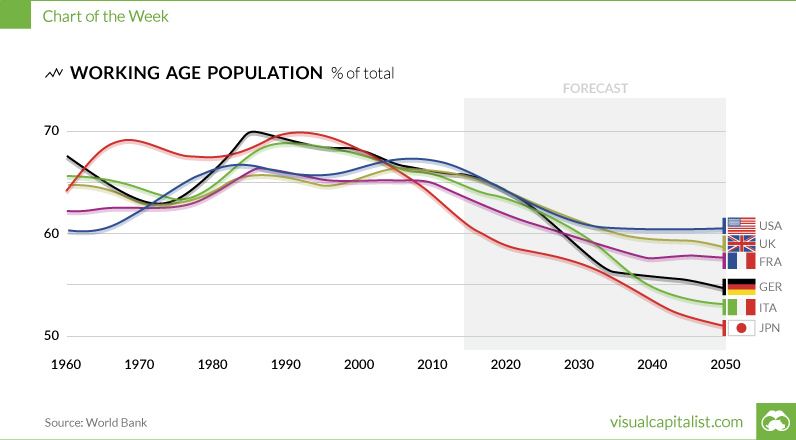
The global increase of elderly dependent populations will have serious economic consequences. Health care costs for the elderly will strain resources, while the smaller working population will struggle to produce enough income tax revenue to support these rising costs. It’s likely this will cause spending power to decrease, consumerism to decline, job production to slow – and the economy to stagnate.
Solutions
Immigration has been a source of short-term population sustenance for many nations, including the U.S. and Britain. However, aside from obvious societal tensions associated with this strategy, immigrants are often adults themselves when they relocate, meaning they too will be elderly dependents soon.
Several nations are already experiencing the effects of a large proportion of elderly dependents. Japan, with one-quarter of its total population currently over the age of 65, has been a pioneer in developing technologies, such as robotics, as a solution to ease strained health care resources. Many countries are restructuring health care programs with long-term solutions in mind, while others are attempting to lower the cost of childcare and education.
Markets
Mapped: The Most Valuable Company in Each Southeast Asian Country
Six businesses in the broader financial space are present on this list of the largest companies, by market cap, in each Southeast Asian country.

The Most Valuable Company in Each Southeast Asian Country
This was originally posted on our Voronoi app. Download the app for free on iOS or Android and discover incredible data-driven charts from a variety of trusted sources.
Southeast Asia has been emerging as an economic powerhouse in the past decade. However, there are very noticeable disparities in the sizes of the largest publicly-traded corporations in countries within the region.
In this visualization, we map the most valuable company in each Southeast Asian country, by their market capitalization in current U.S. dollars as of April 18th, 2024.
Data for this visualization and article is sourced from Companiesmarketcap.com, and the Laos and Yangon stock exchanges.
Southeast Asia’s Biggest Companies are Banks
The most valuable companies in Indonesia and Singapore, Bank Central Asia and DBS Group, are each worth more than $60 billion, and both are banks.
In the quartet of Malaysia, Thailand, Vietnam, and the Philippines, the largest companies by market cap are all worth around $20 billion. Out of the four, two are banks.
| Country | Company | Market Cap |
|---|---|---|
| 🇮🇩 Indonesia | 🏦 Bank Central Asia | $73B |
| 🇸🇬 Singapore | 🏦 DBS Group | $69B |
| 🇲🇾 Malaysia | 🏦 Maybank | $28B |
| 🇹🇭 Thailand | ⛽ PTT PCL | $27B |
| 🇻🇳 Vietnam | 🏦 Vietcombank | $20B |
| 🇵🇭 Philippines | 📈 SM Investments Corporation | $20B |
| 🇰🇭 Cambodia | 🚢 Sihanoukville Autonomous Port | $1B |
| 🇱🇦 Laos | 🏭 LALCO | $312M |
| 🇲🇲 Myanmar | 📈 First Myanmar Investment | $139M |
Note: Figures are rounded, and current as of April 18th, 2024.
Cambodia stands by itself, with its most valuable publicly listed company, Sihanoukville Autonomous Port, worth $1 billion.
Meanwhile, LALCO in Laos is a credit leasing company worth $312 million and Myanmar’s biggest company, First Myanmar Investment, is worth $139 million.
Finally, Brunei and Timor-Leste do not have public stock exchanges, but for different reasons.
Most of Brunei’s economy relies on the state-owned oil sector, which also helps make its sultan the world’s second-richest monarch. However, in Timor-Leste, a small population combined with limited access to credit and liquidity has led to limited opportunities for the creation of publicly-listed companies or an exchange.
-

 Economy7 days ago
Economy7 days agoRanked: The Top 20 Countries in Debt to China
-

 Demographics2 weeks ago
Demographics2 weeks agoThe Countries That Have Become Sadder Since 2010
-

 Money2 weeks ago
Money2 weeks agoCharted: Who Has Savings in This Economy?
-

 Technology2 weeks ago
Technology2 weeks agoVisualizing AI Patents by Country
-

 Economy2 weeks ago
Economy2 weeks agoEconomic Growth Forecasts for G7 and BRICS Countries in 2024
-

 Wealth2 weeks ago
Wealth2 weeks agoCharted: Which City Has the Most Billionaires in 2024?
-

 Technology1 week ago
Technology1 week agoAll of the Grants Given by the U.S. CHIPS Act
-

 Green1 week ago
Green1 week agoThe Carbon Footprint of Major Travel Methods

